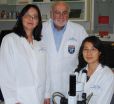(Press-News.org) COLUMBIA, Mo. — Researchers at the University of Missouri School of Medicine have identified epigenetic protein changes caused by binge drinking, a discovery that could lead to treatments for alcohol-related liver diseases.
"We know that chronic alcohol use is damaging to the liver, but binge drinking amplifies that damage," said Shivendra Shukla, Ph.D., Margaret Proctor Mulligan Professor at the MU School of Medicine and lead author of the study.
Excessive alcohol use is one of the most common causes of chronic liver failure. Long-term liver damage from alcohol use is irreversible. Excessive alcohol use is also associated with high blood pressure, heart disease, stroke, cancer and digestive problems.
The National Institute on Alcohol Abuse and Alcoholism defines binge drinking as a pattern of drinking that brings a person's blood alcohol concentration to 0.08 grams percent or above. This typically happens when men consume five or more drinks or women consume four or more drinks over a two-hour period.
"Our latest research shows that epigenetic modifications in histone structures occur within the liver as a result of heavy binge drinking," Shukla said. "Epigenetic alterations are changes in genes that are not caused by changes in the DNA sequence or genetic code."
Histones are proteins that act like a spool to compact and organize the thread-like DNA strands that wrap around them. Histones work to protect the DNA strand and help it function correctly. Although histone modification does occur naturally, Shukla and his team found that binge drinking results in unnatural modifications to histones. In turn, these changes adversely affect how a person's genetic code is interpreted and how it is regulated.
"Every response in the body is due to alterations in proteins," Shukla said. "Binge drinking is an environmental trigger that negatively affects histones by altering the correct binding of DNA. The result is unnecessary replication in the copied structure. This initially causes inflammation and damage to the cells as they form, but it is also eventually the cause of more serious diseases such as cirrhosis and cancer."
Because the liver is the main metabolic site in the body, it is the first organ to experience damage from binge drinking. But because the liver is responsible for nutrient and drug metabolism and distribution, as well as the production of multiple agents that are needed for the heart, kidney, blood vessels and brain to function properly, liver damage can affect many other systems in the body.
"It is important to specify that binge drinking should not be associated only with liver damage," Shukla said. "Binge drinking can create an inflammatory response in the liver that is like a cluster bomb, sending out various damaging signals to other organ systems in the body. If those organs are working at a lower level of function, then a whole host of physiological processes are affected as a consequence of binge drinking."
Shukla says that excessive alcohol consumption with a binge drinking pattern is emerging as a major public health concern globally. In the U.S., binge drinking is the most common form of excessive alcohol use ― so common in fact, that the Centers for Disease Control and Prevention reports approximately one in six adults binge drinks about four times each month.
"This is not a problem that is going away," said Shukla. "It is actually growing. More work is needed on the research we are doing, but findings such as these are very promising and may lead to future treatments for alcohol-related liver damage."
INFORMATION:
The study, "Epigenetic Histone Modifications in a Clinically Relevant Rat Model of Chronic Ethanol-Binge-Mediated Liver Injury" was recently published in Hepatology International, the journal of the Asian Pacific Association for the Study of the Liver.
This news release is available in German. It does seem slightly odd at first: you hold the phone in one hand, and move the other in the air above its built-in camera making gestures that resemble sign language. Sometimes you move your index finger to the left, sometimes to the right. You can spread out your fingers, or imitate a pair of pliers or the firing of a pistol. These gestures are not, however, intended for communicating with deaf people; they are for controlling your smartphone.
By mimicking the firing of a pistol, for example, a user can switch to another ...
The remnants of Hurricane Simon were fanning out over the desert Southwestern U.S. on Oct. 8 and NASA's Aqua satellite captured infrared data on the thunderstorms expected to bring flash flooding.
NOAA's National Weather Service (NWS) indicated on Oct. 8, that Simon's remnants would be bringing heavy rain and the possibility of flash flooding to the desert Southwest. NWS noted "Moisture associated with the remnants of Tropical Storm Simon will bring showers and isolated thunderstorms to parts of the Desert Southwest on Wednesday. Rainfall totals of up to an inch or more ...
A government program to provide health insurance for catastrophic illness to households below the poverty line in Karnataka, lowered both mortality rates and out-of-pocket expenses for the residents, according to a recent evaluation published in the leading global health journal The BMJ.
The program is implemented by the Karnataka government with support from the World Bank Group.
An evaluation of the program, the Vajpayee Arogyashree Scheme (VAS), funded by the World Bank Group and led by Neeraj Sood, professor and director of research at the USC Schaeffer Center for ...
The sports media's positive reaction to the hiring of a female referee in professional football is a good sign, according to a Penn State researcher, but did little to help expose deeper issues that hinder greater acceptance of women in sports.
In a study of online stories and posts about the hiring of Shannon Eastin as an NFL official during the 2012 referee's union strike, Dunja Antunovic, a doctoral candidate in mass communications, said that the media mostly celebrated her NFL debut.
"It was generally positive," said Antunovic. "However, it might be a mistake to ...
COLUMBUS, Ohio – The risk of developing cancer in a salivary gland might be higher in people with mutations in either of two genes associated with breast and ovarian cancer, according to a new study by researchers at The Ohio State University Comprehensive Cancer Center – Arthur G. James Cancer Hospital and Richard J. Solove Research Institute (OSUCCC – James).
Although salivary gland cancer is rare, this retrospective study suggests it occurs 17 times more often in people with inherited mutations in genes called BRCA1 and BRCA2, than those in the general ...
It is estimated that as many as half of patients taking cancer drugs experience a decrease in mental sharpness. While there have been many theories, what causes "chemo brain" has eluded scientists.
In an effort to solve this mystery, neuroscientists at The University of Texas Health Science Center at Houston (UTHealth) conducted an experiment in an animal memory model and their results point to a possible explanation. Findings appeared in The Journal of Neuroscience.
In the study involving a sea snail that shares many of the same memory mechanisms as humans and a drug ...
Certain types of corals, invertebrates of the sea that have been on Earth for millions of years, appear to have found a way to survive some of their most destructive threats by attaching to and growing under mangrove roots.
Scientists with the U.S. Geological Survey and Eckerd College recently published research on a newly discovered refuge for reef-building corals in mangrove habitats of the U.S. Virgin Islands. More than 30 species of reef corals were found growing in Hurricane Hole, a mangrove habitat within the Virgin Islands Coral Reef National Monument in St. John.
Corals ...
CHAMPAIGN, Ill. — A new study offers fresh insights into how talking on a cell phone or to a passenger while driving affects one's performance behind the wheel. The study used a driving simulator and videophone to assess how a driver's conversation partner influences safety on the road.
"We've done years of study on driver distraction, and previous studies suggest that passengers often aren't distracting. In fact, passengers can be helpful, especially if they're adults who have had experience and also are active drivers themselves," said University of Illinois psychology ...
Peer-to-peer file sharing of movies, television shows, music, books and other files over the Internet has grown rapidly worldwide as an alternative approach for people to get the digital content they want -- often illicitly. But, unlike the users of Amazon, Netflix and other commercial providers, little is known about users of peer-to-peer (P2P) systems because data is lacking.
Now, armed with an unprecedented amount of data on users of BitTorrent, a popular file-sharing system, a Northwestern University research team has discovered two interesting behavior patterns: ...
Cold Spring Harbor, NY – It's one of those ideas that seems to make perfect sense: the bigger the brain, the more intelligent the creature. While it is generally true, exceptions are becoming increasingly common. Yet the belief persists even among scientists. Most biologists, for example, assume that rats, with larger brains, are smarter than mice. Cold Spring Harbor Laboratory (CSHL) scientists now challenge this belief. They compared mice and rats and found very similar levels of intelligence, a result that could have powerful implications for researchers studying ...




